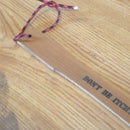Introduction: How to Make a Center Finder Tool
I am a pen turner and have started making my own pen blanks. I enjoy making my own blanks rather than buying them because I can choose my own wood and I know I am sourcing my wood from salvage or renewable sources.
To make your own pen blanks I need to be able to drill a hole through the center of the blank. To drill the hole it is necessary to find the center of the blank. The first few times I just used my 6" speed square and lined up the corners to strike a line. Since my blanks are so small, the speed square is just too large and bulky making it difficult to hold everything still and get accurate lines to find the center of a blank.
I started looking at buying a center finder tool and found there are several types of tools to buy ranging in price from $5 to $30. $30 for such a simple tool? I do not think so. Add shipping to the price and even the $5 tool is a little too pricey. So, I decided I would build my own tool using my laser cutter/engraver and some scrap wood.
So, just a few minutes drawing the tool file on CorelDraw, less than a minute cutting it out on my laser cutter, and a couple minutes gluing them together and I have not one but two center finder tools for the cost of a little time!
Do not worry if you do not have a laser cutter or access to one, you could use my pattern to cut it on a band saw. Or if you want just draw my pattern on a piece of cardboard (such as the back of a legal pad) and cut it out with a razor knife.
Step 1: Pattern for the Tool
I used CorelDraw to draw my parts file. I do a lot of engraving and own a laser engraver. If you don't have one, that is fine. You can cut the parts on your band saw or just cut it from cardboard. I have included the drawings for you to use in cdr and pdf formats.
I drew a 1.25" circle and "cut out" a 90 degree slice. This is the part that acts as a square.
I then drew another 1.25" circle with a radius line to help me line up the tongue of the tool when I assemble it.
The tongue was drawn with an arc to match the circle at the back end and a point at the front end of the tongue. The tongue is 2" long at the longest point.
This tool is good for use with stock up to about one inch or maybe a little bigger. If you need to use it on larger stock just scale the tool up to accommodate your stock.
Step 2: Cut Out the Parts
Now it is just a matter of sending the file to the laser and letting it cut out the parts. I used some scrap 1/8" thick alder wood I had sitting in my shop. I would recommend using a stable hardwood in 1/8" or 1/4" thickness or Baltic birch plywood in the same thickness. Do not use a material that will be susceptible to warping or structural changes due to humidity, temperature changes if you want the tool to last. You could also use acrylic.
If you cut this tool from a piece of cardboard it will work just as well as mine but will, of course, only be a temporary tool that will last only a few uses.
Step 3: Assemble and Use the Tool
Now, just assemble the tool. I used a few drops of super glue to put it together. Just make sure the tongue lines up properly with the circle and the "missing slice". You can make sure it lines up well by lining it all up on a square blank of wood such as a pen blank.
The pictures show the tool being used to mark the center of a pen blank and a dowel. Just insert the blank in the tool and strike a line, rotate the blank to the next corner and strike another line. This is generally accurate enough for most square pen blanks. If you want an even more accurate center, rotate the tool and strike a line at all four corners.
To mark a dowel or round stock, strike a line. Rotate 180 degrees, strike a second line. Rotate 90 degrees and strike a third line. This will give the most accurate center.
That's it. A very simple tool for marking centers on small items. If you need to use it on larger items, just scale the drawings up to accommodate what you are using it for.

Participated in the
Full Spectrum Laser Contest 2016













